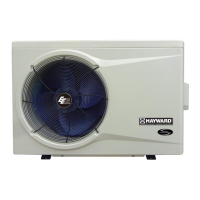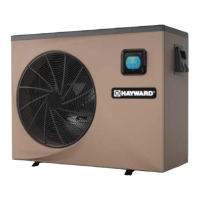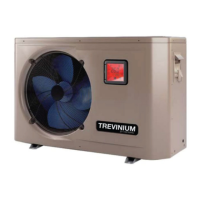USE ONLY HAYWARD GENUINE REPLACEMENT PARTS
24
Two-Speed Pump
In a few cases the flow from a two-speed pump is below the minimum required to operate the water flow switch on the heater. In these cases the pump must
be run at high speed to operate the heater. If the pump and piping arrangement are such that the required minimum flow cannot be obtained, do not attempt
to operate the heater. Correct the installation.
NOTICE - Heater installation, checkout, and start-up should now be completed. BE SURE to leave this manual with the pool owner.
Maintenance & Service
PERIODIC INSPECTION: The heater is designed and built for long performance life when installed and operated according to the manufacturer’s directions.
Regular inspection by qualified service personnel is recommended to keep the heater working properly. The following inspection points are suggested to help
maximize heater life.
1. Periodically check the fan discharge area. The fan discharge must never be obstructed in any way and minimum clearances must be observed.
Remember that shrubs grow and in time may obstruct
2. Keep the entire pool heater area clean and free of all debris, corrosive materials, and other flammable vapors and liquids. Remove any leaves or
paper from around the heater.
3. Do not store chlorine, other pool chemicals, or other corrosives in the vicinity of the heater.
4. Do not use the heater if any part has been under water. Contact a qualified service technician to inspect the entire heater and replace any part of
the control system that was under water. If heater has been totally submerged in water it must be removed and the entire heater must be replaced.
5. An inspection program is a good preventative maintenance measure. Keep this manual in a safe place for future reference for yourself as well
as for a service technician to consult when inspecting or servicing the heater. Additional inspection procedures to be performed by a qualified
service technician.
Water Chemistry
WARNING - Water Chemistry. Failure to maintain proper water chemistry may cause premature heat exchanger damage or failure.
The heat exchanger in your pool heater is made from the highest quality of materials. The titanium condenser is a premium material and the processes used
to manufacture the heat exchanger are state of the art in pool heater design and manufacture. However, it remains vital that the heat exchanger be protected
from damaging or corrosive chemicals, insufficient water flow or improperly balanced water chemistry. Heat exchanger damage or failure resulting from im-
proper flow, improperly balanced pool water or the improper addition of sanitizer into the water is NOT covered under the terms of the warranty. The following
factors are critical to heat exchanger protection. Follow these guidelines to help prevent pre-mature damage or failure to your heater and heat exchanger.
1. WATER FLOW THROUGH HEATER Water must be flowing through the heater at the minimum rated flow rate during operation. Check that the pump
is operating and the system is filled with water and purged of all air prior to starting the heater. The minimum rated flow rates are listed in the
specifications section.
2. WATER CHEMISTRY: The chemistry balance and mineral content of swimming pool and spa water changes rapidly due to the addition of sanitizing
chemicals, user loads, exposed rain, runoff and the amount of sun - to name a few. Improper chemistry (See Table4) balance and mineral content
can cause scaling and deposits to form on pool walls, in the filtration system, in the heat exchanger tubes and additionally can promote corrosive
TABLE 4: Water Chemistry
Chemical Recommended Level Effect of Low Levels Effect of High Levels
Chlorine 1 - 3 ppm
hazy water, algae growth, bacteria
causing infections
swimmer irritation, bleaching of
clothes/hair, corrosive to heat
exchanger
Bromine 2 - 4 ppm
pH 7.4 - 7.6
corrosive to heat exchanger,
swimmer irritation
cloudy water, scaling of heat
exchanger, reduced sanitizer
effectiveness
Total Alkalinity 80 -120 ppm
corrosive to heat exchanger,
large fluctuations in pH
scaling of heat exchanger
Calcium Hardness 200 - 400 ppm corrosive to heat exchanger scaling of heat exchanger
Salt 2700 - 5000 ppm poor salt chlorinator performance corrosive to heat exchanger

